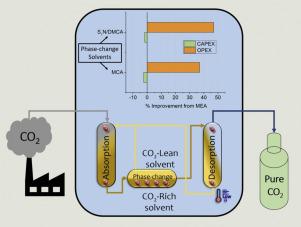Chemical Engineering Research and Design ( IF 3.9 ) Pub Date : 2021-09-03 , DOI: 10.1016/j.cherd.2021.08.036 Panagiotis Kazepidis 1, 2 , Athanasios I. Papadopoulos 1 , Fragkiskos Tzirakis 1 , Panos Seferlis 1, 2

|
Phase-change solvents (PCSs) is a class of chemicals that promises significant cost reductions in post-combustion CO2 capture. However, their use in the design of efficient absorption/desorption processes is challenged by their non-ideal behavior. A generic and flexible model is proposed for the design of phase-change CO2 capture process systems, that enables the effective identification of highly performing flowsheet configurations and recycle stream redistribution policies. The validation of the model using experimental data for the PCS mixture of MAPA/DEEA (3-(Methylamino)-Propylamine/2-(Diethylamino)-Ethanol) indicates only 4% and 0.5% differences in the reboiler duty and in the absorption and desorption temperatures. The novel PCS mixture of S1N/DMCA (N-Cyclohexyl-1,3-Propanediamine/N,N-Dimethylcyclohexylamine) and the PCS MCA (N-methylcyclohexylamine) are used in the optimum design of CO2 capture process units in two industrial cases; a quicklime production plant and a gas-fired power plant. The reboiler duty of S1N/DMCA reaches 2.1 GJ/ton CO2 and the solvent exhibits up to 47% lower operating costs than the conventional MEA (Monoethanolamine), with only 1.7% higher capital costs. The loading of S1N/DMCA reaches up to 1.35 mol CO2/mol of solvent at the exit stream of the phase-separator, whereas this solvent exhibits up to 181% higher CO2 release efficiency than MEA in the desorber. S1N/DMCA is an excellent option for plants with flue gas CO2 concentration as low as 3.5 mol%.
中文翻译:

使用相变溶剂的工业燃烧后 CO2 捕获过程的优化设计
相变溶剂 (PCS) 是一类有望显着降低燃烧后 CO 2捕获成本的化学品。然而,它们在设计高效吸收/解吸过程中的应用受到其非理想行为的挑战。为相变 CO 2捕获工艺系统的设计提出了通用且灵活的模型,该模型能够有效识别高性能流程配置和循环流再分配策略。使用 MAPA/DEEA(3-(甲氨基)-丙胺/2-(二乙氨基)-乙醇)的 PCS 混合物的实验数据验证模型表明,再沸器负荷和吸收和解吸温度。S 1 N/DMCA的新型 PCS 混合物(N-环己基-1,3-丙二胺/ N , N-二甲基环己胺)和PCS MCA(N-甲基环己胺)在两个工业案例中用于CO 2捕集工艺装置的优化设计;生石灰生产厂和燃气发电厂。S 1 N/DMCA的再沸器负荷达到 2.1 GJ/ton CO 2并且该溶剂的运行成本比传统的 MEA(单乙醇胺)低 47%,资本成本仅高 1.7%。S 1 N/DMCA的负载量在相分离器的出口流处高达 1.35 mol CO 2 /mol 溶剂,而该溶剂的 CO 2含量高达 181%在解吸器中的释放效率高于 MEA。S 1 N/DMCA 是烟气 CO 2浓度低至 3.5 mol% 的工厂的绝佳选择。


























 京公网安备 11010802027423号
京公网安备 11010802027423号